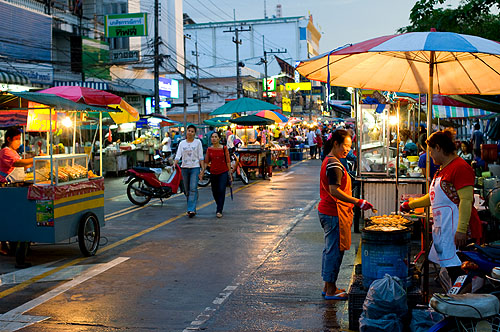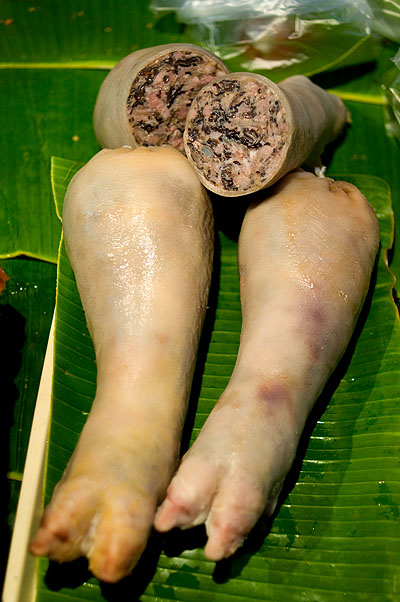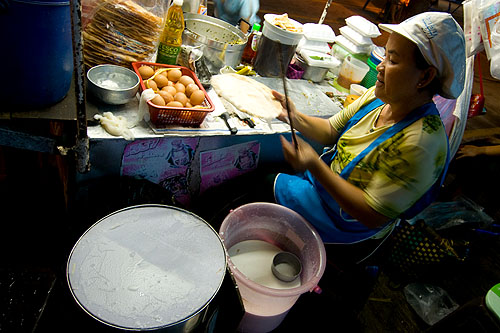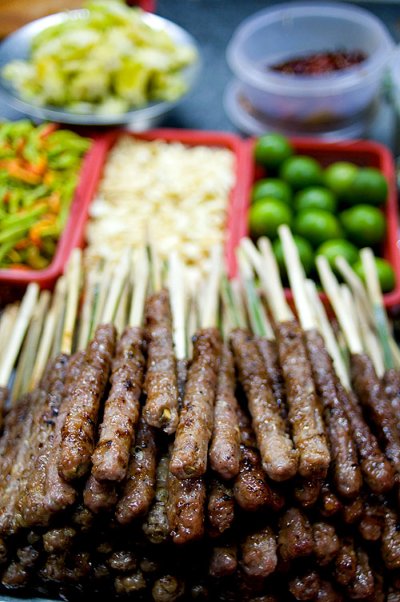 One thing I particularly love about eating out in Bangkok is the informality. I've witnessed firsthand the hoops that people have to go through simply to eat out (not to mention the prices associated with this) in most other big cities around the world, and love the fact that I can virtually waltz into just about any place in town on a whim. Come to think of it, I don't think I've ever even had to make a reservation for a restaurant in Bangkok. Until now, that is.
One thing I particularly love about eating out in Bangkok is the informality. I've witnessed firsthand the hoops that people have to go through simply to eat out (not to mention the prices associated with this) in most other big cities around the world, and love the fact that I can virtually waltz into just about any place in town on a whim. Come to think of it, I don't think I've ever even had to make a reservation for a restaurant in Bangkok. Until now, that is.
That reservations are necessary at Jok, a tiny restaurant in a tiny alley in Chinatown, is not surprising, given that the restaurant only has four tables. This is actually a significant increase from the time when Jok was famous for having a single table. But despite the 400% increase in seating, a three-month wait is still the norm here, and according to Mr Jok himself, no amount of money or rank will influence this. Luckily I have friends with more connections than myself who were able to take advantage of a last-minute cancellation. So on a recent Saturday the five of us headed over to Chinatown for a particularly decadent lunch.
There's no menu at Jok, and arriving at the restaurant, we were simply seated and told of what was available. We were begun with wontons:

which were generously stuffed with shrimp and topped with a delicious blanket of crispy deep-fried garlic. Almost dumpling-like, they appeared to have been steamed rather than boiled.
Possibly my favourite dish was a platter of smoked meats, including fatty pork, pork tongue and duck:

The meats had the slightest whiff of alcohol (Chinese cooking wine, we theorised), coupled with a favourable fattiness and a rich smokiness. The dish wasn't necessarily indicative of the chef's skills, but did show his talent for choosing high quality ingredients.
There were deep-fried snowfish steaks served on a bed of iceberg lettuce:

This was probably my least favourite dish of the meal. I've always found snowfish (plaa hima) impressive looking, but underwhelming in the flavour department. And if you ask me, iceberg lettuce belongs on Big Macs and not much else.
This was followed by steamed crab (pictured at the top of this post). In talking to chef Jok after dinner, we learned that his family had been in the crab business for 70 years. Indeed, it was while delivering seafood to Chinatown's various restaurants, he explained, that he 'learned' many of the recipes that later became the basis of his restaurant. It goes without saying that Jok knows his crab, and this was by far the meatiest I've ever come across, although unfortunately it appeared to have been steamed long before reaching our table.
We loved the abalone stir-fried with dried musrhooms and Chinese kale:

Until, that is, Mr Jok matter-of-factly informed us that it was mock abalone (apparently made from squid). Regardless, for me at least, this took nothing away from the peppery spiciness of the sauce and the delicious mushrooms and kale--my favourite parts of the dish.
Next was a dish of prawns deep-fried with ginkgo nuts:

This also turned out to be slightly disappointing, as the prawns were overcooked. I did like the texture of the ginkgo nuts though, which were pleasantly rubbery, not floury as I expected.
I really enjoyed Jok's 'Old-fashioned fried rice':

which contained more of that deliciously smokey pork (one of our group bought half a kilo to take home). According to one of the cooks, making the dish involved steaming rice, cooling it under a fan, refrigerating it overnight, separating the grains, and then slowly frying it, to allow the flavours of the various ingredients to penetrate the rice. It works, and the grains of rice were both rich, as well as separate and not overcooked.
Fried rice was followed by a delicious soup of grouper and pickled greens, and we assumed our meal was over at this point, but Mr Jok wanted us to try his most recent menu item, shrimp-and-fishcakes:

Part of the postprandial ceremony is the obligatory picture with Chef Jok himself:

And of course, if you'd like to come back, the reservation:

I suspect there'd be a minor catastrophe if this book was lost. Our next visit? Sometime in November.
Jok (Google Maps link)
23 Trok Issaranuphap
Chinatown, Bangkok
02 221 4075, 02 623 3921, 081 919 9468
 Bang Saen, the nearest beach from Bangkok, was the topic of my first blog post. That was way back in 2005, and I think I've only been back once since then. It was high time for a re-run, so with Hock and Maytel and their mad wheelz, A, and all of our empty stomachs, we headed out on a recent Sunday.
Bang Saen, the nearest beach from Bangkok, was the topic of my first blog post. That was way back in 2005, and I think I've only been back once since then. It was high time for a re-run, so with Hock and Maytel and their mad wheelz, A, and all of our empty stomachs, we headed out on a recent Sunday.

















 Kuaytiaw khua kai, wide rice noodles fried with chicken and egg, is a dish found all over Bangkok's Chinatown. I've had it a couple times, but have never been blown away, usually finding it often too bland or too oily. However a recent peek into a normally dark alleyway revealed the best take on the dish so far.
Kuaytiaw khua kai, wide rice noodles fried with chicken and egg, is a dish found all over Bangkok's Chinatown. I've had it a couple times, but have never been blown away, usually finding it often too bland or too oily. However a recent peek into a normally dark alleyway revealed the best take on the dish so far.

 One thing I particularly love about eating out in Bangkok is the informality. I've witnessed firsthand the hoops that people have to go through simply to eat out (not to mention the prices associated with this) in most other big cities around the world, and love the fact that I can virtually waltz into just about any place in town on a whim. Come to think of it, I don't think I've ever even had to make a reservation for a restaurant in Bangkok. Until now, that is.
One thing I particularly love about eating out in Bangkok is the informality. I've witnessed firsthand the hoops that people have to go through simply to eat out (not to mention the prices associated with this) in most other big cities around the world, and love the fact that I can virtually waltz into just about any place in town on a whim. Come to think of it, I don't think I've ever even had to make a reservation for a restaurant in Bangkok. Until now, that is.








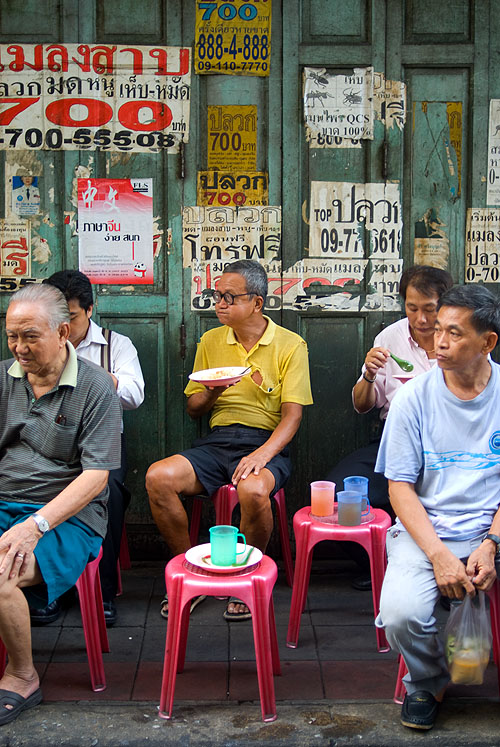 A curry dinner at Jek Pui, a popular stall in Bangkok's Chinatown that has no tables.
A curry dinner at Jek Pui, a popular stall in Bangkok's Chinatown that has no tables. 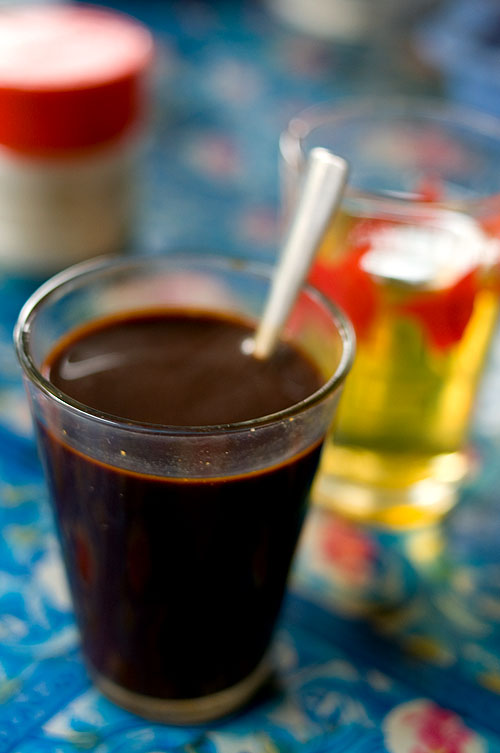 It's by no means the best coffee in the world, and often the amount of sweetened condensed milk is enough to give a diabetic nightmares, but the combination of product and place makes Lao coffee a mighty satisfying brew.
It's by no means the best coffee in the world, and often the amount of sweetened condensed milk is enough to give a diabetic nightmares, but the combination of product and place makes Lao coffee a mighty satisfying brew.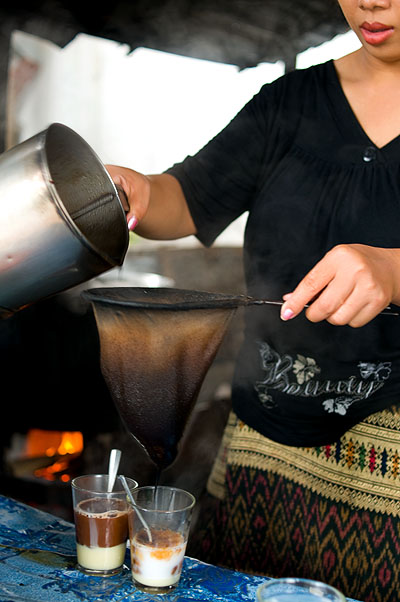
 This may sound like a macabre title for blog post, but anybody who's been to a Buddhist funeral in Southeast Asia knows the events take a decidedly different form here. For starters, funerals in this part of the world are more like family reunions, and are generally festive, rather than dour in atmosphere. They can often last several days, depending on the family's budget. And most importantly, like much of life in Southeast Asia, they tend to revolve around food.
This may sound like a macabre title for blog post, but anybody who's been to a Buddhist funeral in Southeast Asia knows the events take a decidedly different form here. For starters, funerals in this part of the world are more like family reunions, and are generally festive, rather than dour in atmosphere. They can often last several days, depending on the family's budget. And most importantly, like much of life in Southeast Asia, they tend to revolve around food.






 At Phonsavan's evening market.
At Phonsavan's evening market. 






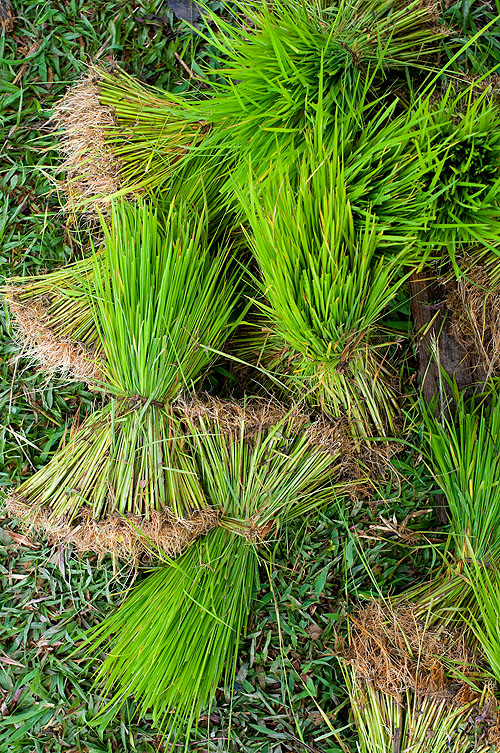 Known in these parts as khao niaow, I could eat this stuff all day. In Laos that's easier done than said. And at the moment, I'm also fortunate enough to witness the first stage in rice production:
Known in these parts as khao niaow, I could eat this stuff all day. In Laos that's easier done than said. And at the moment, I'm also fortunate enough to witness the first stage in rice production:
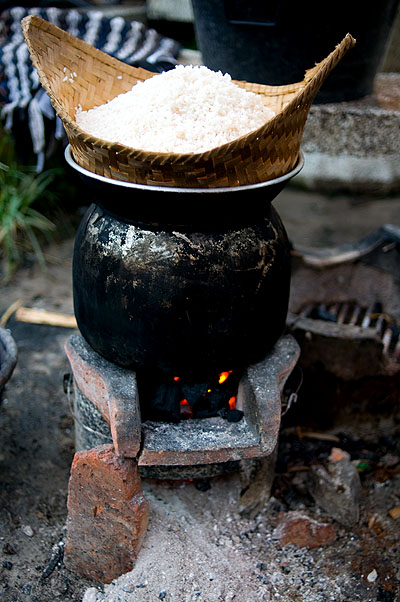
 Yes, I realize these fantastically delicious baguette sandwiches are Vietnamese/French in origin, but they're virtually nonexistent in Thailand and are one of the things I look forward to eating when in Laos. More Things I Like About Laos to follow...
Yes, I realize these fantastically delicious baguette sandwiches are Vietnamese/French in origin, but they're virtually nonexistent in Thailand and are one of the things I look forward to eating when in Laos. More Things I Like About Laos to follow... And no, it's no isaan (northeastern Thailand). A pretty easy challenge for most of you, I imagine...
Sorry blogs have been slow in coming, but I'm on the road at the moment and have little time to spend at the computer. When I'm a bit more stationary, I'll be blogging on some of the interesting stuff I've seen and eaten in this country. In the meantime, be sure to check out the feature I've done on
And no, it's no isaan (northeastern Thailand). A pretty easy challenge for most of you, I imagine...
Sorry blogs have been slow in coming, but I'm on the road at the moment and have little time to spend at the computer. When I'm a bit more stationary, I'll be blogging on some of the interesting stuff I've seen and eaten in this country. In the meantime, be sure to check out the feature I've done on  Nang Loeng Market, located just north of Banglamphu, off Th Nakhorn Sawan, is among the city's oldest continuously operating markets. The recipient of a recently-finished makeover culminating in a fresh coat of paint, new tiles and a rather garish sign, Nang Loeng Market is hardly looking its 100+ years. However, in all honesty, the label 'market' is a bit of misnomer here. The Nang Loeng of today resembles something more of a food court than a fresh market, and the main hall is dominated not by piles of greens or still-flapping fish, but rather by stalls selling prepared dishes:
Nang Loeng Market, located just north of Banglamphu, off Th Nakhorn Sawan, is among the city's oldest continuously operating markets. The recipient of a recently-finished makeover culminating in a fresh coat of paint, new tiles and a rather garish sign, Nang Loeng Market is hardly looking its 100+ years. However, in all honesty, the label 'market' is a bit of misnomer here. The Nang Loeng of today resembles something more of a food court than a fresh market, and the main hall is dominated not by piles of greens or still-flapping fish, but rather by stalls selling prepared dishes:







 as seen in Bangkok's Chinatown. Any idea what this stall serves?
as seen in Bangkok's Chinatown. Any idea what this stall serves? Tim Hetherington's image of US soldier in Afghanistan is the 2007 World Press Photo Photo of the Year.
Tim Hetherington's image of US soldier in Afghanistan is the 2007 World Press Photo Photo of the Year.  As the painfully obvious name ('Phat Thai House') suggests, this is indeed a phat thai restaurant, but there are no noodles in today's post. Rather, walking by this tiny shophouse restaurant in Olde Bangkok, I was drawn to the vast array of ingredients used to make khao khluk kapi, rice cooked in shrimp paste and served with a vast array of toppings. This is one of my favourite Thai dishes, and as it seems to be little-known among visitors to Thailand, I've been working tirelessly to promote it, with previous mentions
As the painfully obvious name ('Phat Thai House') suggests, this is indeed a phat thai restaurant, but there are no noodles in today's post. Rather, walking by this tiny shophouse restaurant in Olde Bangkok, I was drawn to the vast array of ingredients used to make khao khluk kapi, rice cooked in shrimp paste and served with a vast array of toppings. This is one of my favourite Thai dishes, and as it seems to be little-known among visitors to Thailand, I've been working tirelessly to promote it, with previous mentions 
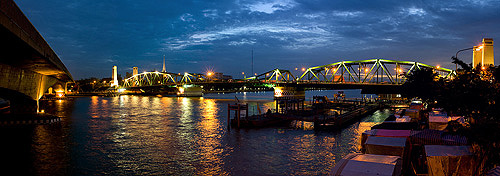 Bangkok's Saphan Phut, Memorial Bridge, at night. A composite of five separate images stitched together with Photoshop CS3's Photomerge function. For larger image, go
Bangkok's Saphan Phut, Memorial Bridge, at night. A composite of five separate images stitched together with Photoshop CS3's Photomerge function. For larger image, go  Apparent apathy at Bangkok's central train station.
Apparent apathy at Bangkok's central train station. In reading Suthon Sukphisit's excellent Cornucopia column, which runs every Saturday in the
In reading Suthon Sukphisit's excellent Cornucopia column, which runs every Saturday in the 





 Nong New, a stall in Bangkok's Chinatown, specialises in a few dishes that you're more than likely to run into in this part of town: birds' nest and shark fin soup. I've had bird nest soup a couple times, and find it too sweet for my taste. And shark fin soup is a ridiculous dish that's more superstition than cuisine. But there's still reason to visit Nong New's stall; he's known for making some of the best phat mee hong kong, 'Hong Kong-style fried noodles', in the area:
Nong New, a stall in Bangkok's Chinatown, specialises in a few dishes that you're more than likely to run into in this part of town: birds' nest and shark fin soup. I've had bird nest soup a couple times, and find it too sweet for my taste. And shark fin soup is a ridiculous dish that's more superstition than cuisine. But there's still reason to visit Nong New's stall; he's known for making some of the best phat mee hong kong, 'Hong Kong-style fried noodles', in the area:
 Ladyboy prostitute, Bangkok's Chinatown
Ladyboy prostitute, Bangkok's Chinatown




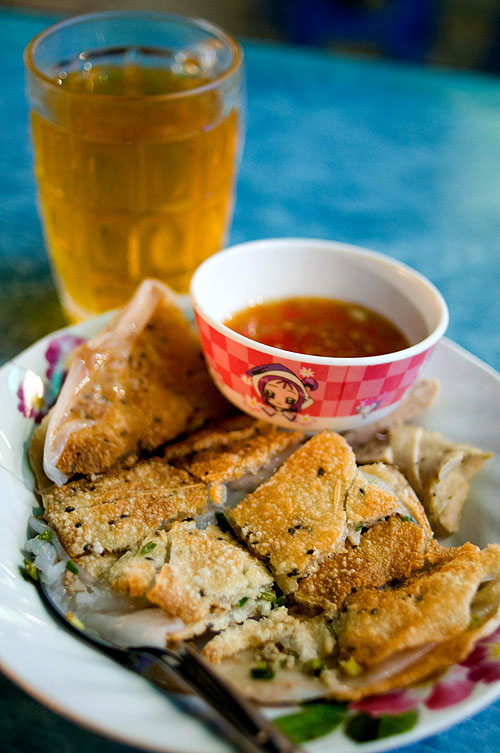 Mukdahan is probably the least known and quietest of Thailand's large cities located along the Mekong. Despite this, it had one of the region's best night markets:
Mukdahan is probably the least known and quietest of Thailand's large cities located along the Mekong. Despite this, it had one of the region's best night markets: